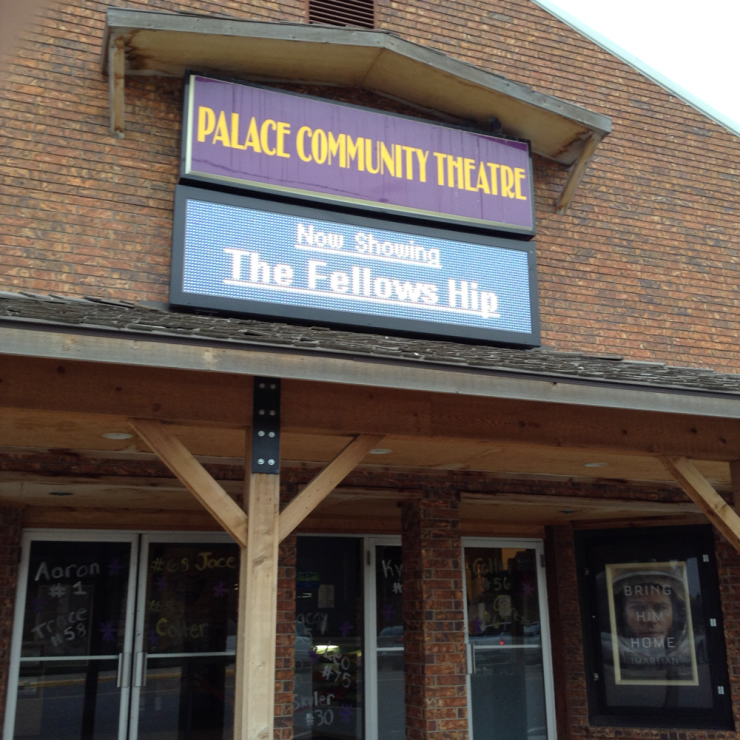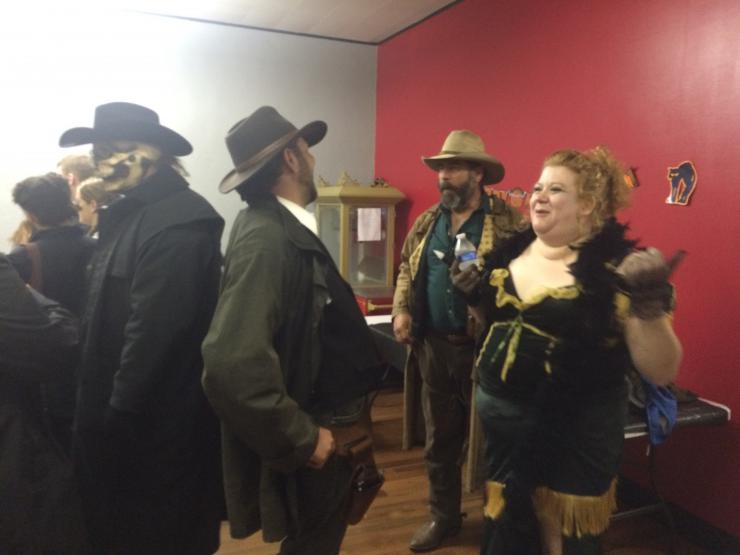Red Carpet Academy
Celebrating the Arts in Western Kansas
In October, I participated in a workshop for gifted and talented middle and high school students from multiple schools in northwest Kansas, which took place at the Northwest Kansas Educational Service Center (NKESC) in Oakley—about fifty miles from the fourth-generation family farm in Gove County where my mother grew up. Almost eighty students gathered for the “Red Carpet Academy,” a day celebrating the performing and cinematic arts. The day kicked off with a screening of The Fellows Hip: Rise of the Gamers, an independent film about teenage Lord of the Rings OnlineTM gamers (in which I played Nate Bingley), and continued with hour-long workshops in theatre games and improvisation (led by myself), creative writing (led by playwright and HowlRound columnist Catherine Trieschmann), and cinematography/videography (led by Fort Hays State University video production instructor Andrew Tincknell).

It is my hope that, by presenting students with artists who make art in Kansas, we can present to them the possibility of returning home again, or even of staying and making art in a rural community.
I wasn’t sure what to expect. I knew that the performing arts in Kansas couldn’t compete with sports for funding (like everywhere else), or with the Future Farmers of America (an essential element of a rural education). I knew that young people spoke of western Kansas as someplace to “escape”—perhaps with a college scholarship from the Hansen Foundation, a major benefactor to the students and communities of northwest Kansas (and a sponsor of the workshop).
However, I also knew that the rural high school that my cousins attended, Quinter High School, won the state’s Speech and Drama Championship four out of the last ten years. Almost half of Quinter High students are on the speech and drama team, commonly known as “forensics,” which includes competitions such as solo and duet acting. A recent article in the Salina Journal quotes Quinter student Kara Hinman saying that forensics is “‘really big…It’s more popular than football, or volleyball, or any of the other sports—everybody wants to be in forensics.’” And I experienced other local artistic activity—my cousin’s wife recently directed Quinter’s fall play; another cousin and her son are regular participants in the Hays Community Theater; and my friends are board members of the Western Plains Arts Association. I also remember attending a local production of The Sound of Music as a child, possibly at the Grainfield Opera House—located in a town with a population of 275.

What I found were dozens of kids who threw themselves into theatre games with enthusiasm and courage. They easily picked up the building blocks of improvisation through the “Yes, and…” game, taking turns to build a story as we went around the circle. (There were multiple requests to repeat the game, and I noticed shark attacks and rainbow-colored unicorns were common themes between student groups.) More challenging short two-person improvised scenes found life when students focused on being present with each other through a shared activity, rather than standing in front of each other trying to come up with “funny” lines.
During question and answer sessions, students asked intelligent questions about filmmaking, such as how we found the locations for The Fellows Hip and researched our gamer characters. They also expressed interest in continued participation in the performing arts. One young woman wanted to know how she could prepare for an acting career while still a high school student in northwest Kansas. My answers boiled down to three actions:
- Act a lot. Do as much theatre as you can. Take theatre class if it’s offered, participate in all the school plays, and audition for community theatre as often as possible.
- Read a lot. Take advantage of online publications like HowlRound, Backstage, and Showfax’s columns, and books like Todd London’s An Ideal Theater to learn as much as you can about the business and the history of theatre as a whole.
- Make a lot. With an iPhone and a computer, a kid in western Kansas can write a script, shoot it, edit it, and post it on YouTube. As Steven Spielberg said: “The Internet is going to effect the most profound change on the entertainment industries combined. And we’re all gonna be tuning into the most popular Internet show in the world, which will be coming from some place in Des Moines.” Grab your friends, rent out the Grainfield Opera House, and put on a show, or make a movie.
Valerie Brown-Kuchera, the NKESC staffer who put together the “Red Carpet Academy,” wanted to show the kids that they too could have roots in western Kansas and create art. Therefore, we rounded up mostly local workshop presenters: both Catherine Trieschmann and Andrew Tincknell practice their art in Hays, Kansas. On the other hand, Trieschmann built a playwriting career in major East Coast cities before moving to Kansas, and Tincknell worked in television production in a larger city before returning to teach in Hays. Is it necessary to leave Kansas in order to make a career in the arts? And if we encourage them to pursue in the arts, are we telling them to “get the hell outta Dodge”?
It is my hope that, by presenting students with artists who make art in Kansas, we can present to them the possibility of returning home again, or even of staying and making art in a rural community. For example, there’s nothing preventing a group of Fort Hays State grads from creating the kind of theatre company envisioned by rural arts advocate Scott Walters: a resident ensemble which creates art with and for its local community, while putting its members’ FFA skills to use growing vegetables and making honey.
Brown-Kuchera notes that distance, rather than lack of interest, is the primary obstacle to arts participation in western Kansas. “Some of the students were bused well over an hour” to get to the Red Carpet Academy, Brown-Kuchera said. From Quinter, it is a four-hour drive one-way to get to the Equity theatres in Denver or Kansas City. Touring companies like Ride into History help close the distance by traveling to schools, churches, and community centers throughout the state, but grants from public and private funding (such as local arts commissions or the Hansen Foundation) are generally necessary to help cover the high transportation costs.
A resident ensemble may be able to support itself in a college town such as Hays (by combining side jobs and cottage industries with theatre), but working from one’s rural hometown would require touring, and being dependent on the grant money that makes such tours possible. It is a difficult life in the arts, but it can be done—as long as communities maintain the funding that allows artists to make a living in their own hometowns, and share their stories with the next generation.


Comments
The article is just the start of the conversation—we want to know what you think about this subject, too! HowlRound is a space for knowledge-sharing, and we welcome spirited, thoughtful, and on-topic dialogue. Find our full comments policy here